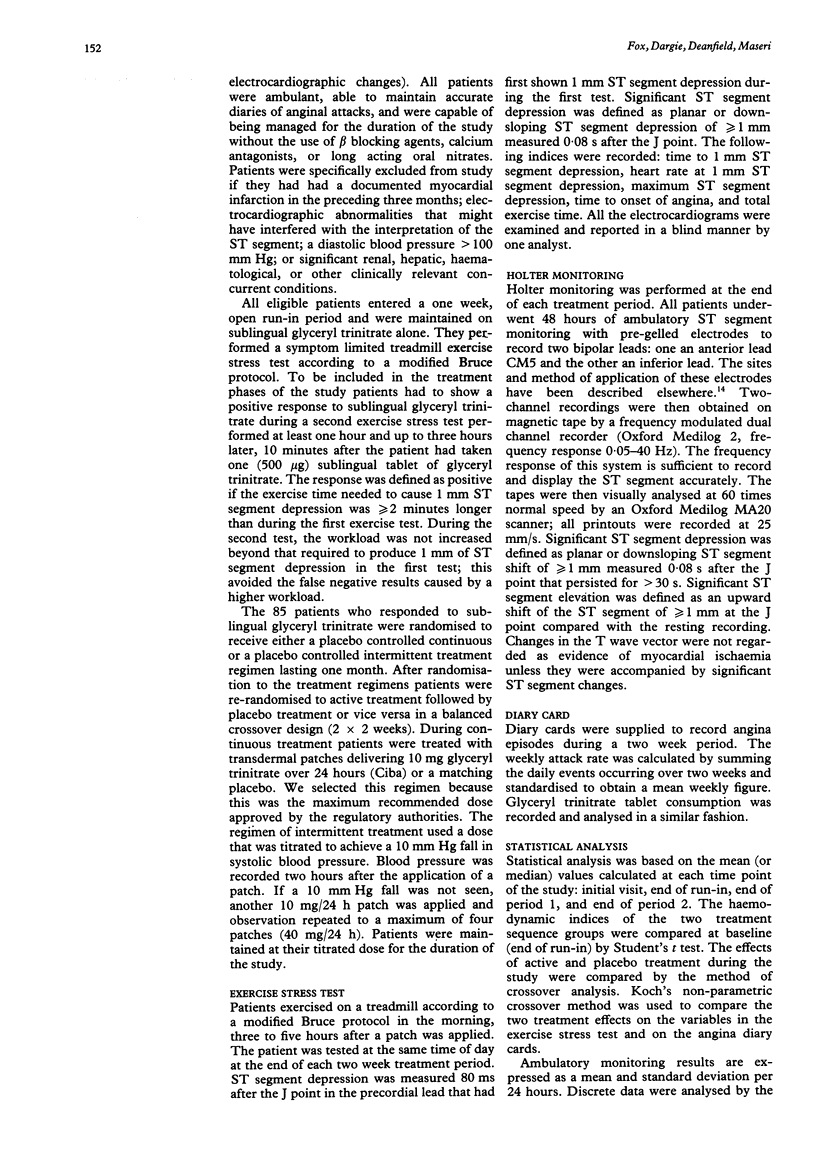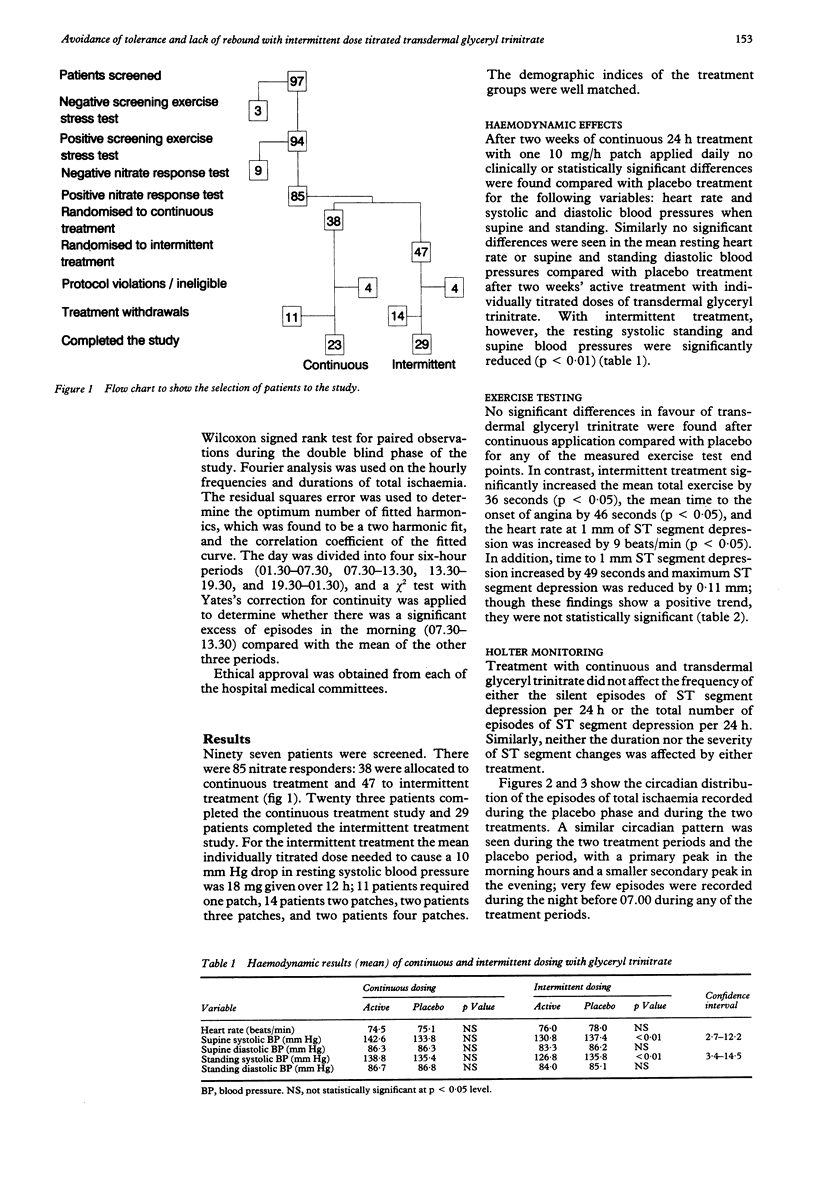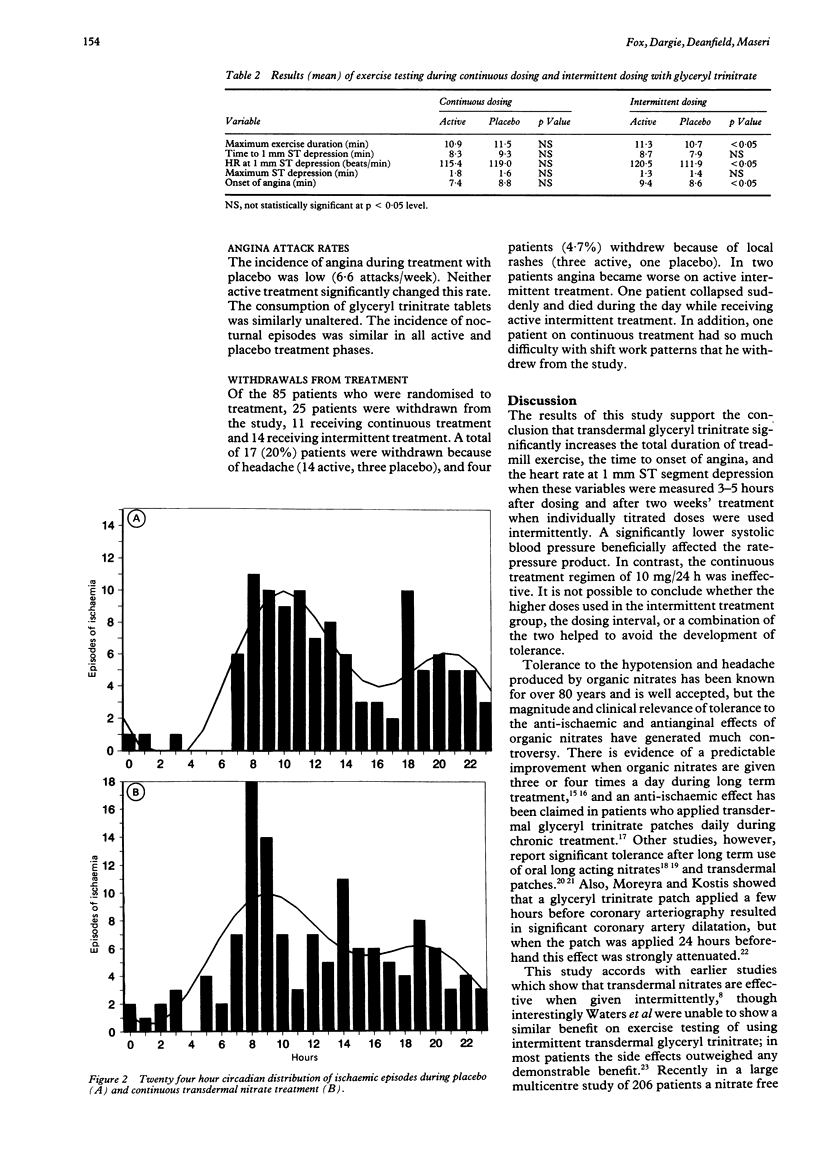Abstract
OBJECTIVES--To investigate the efficacy of transdermal glyceryl trinitrate given continuously and with a nocturnal nitrate free period. DESIGN--Double blind placebo controlled study with two parallel limbs. SETTING--Multicentre trial. PATIENTS--52 patients randomised to receive either continuous treatment (23 patients) or intermittent treatment with an individually titrated dose (29 patients) for 14 days: both treatments were compared with placebo in a cross-over fashion. INTERVENTION--Continuous treatment with 10 mg per 24 hours of transdermal glyceryl trinitrate or intermittent transdermal glyceryl trinitrate titrated to give an arbitrary 10 mm Hg drop in systolic blood pressure (mean dose 18.2 mg) given over approximately 16 hours. MAIN OUTCOME MEASURE--Treadmill exercise stress testing and ambulatory monitoring of the ST segment after 14 days' treatment. RESULTS--After 14 days' intermittent treatment resting supine and standing systolic blood pressure fell by 7.5 mm Hg (95% confidence interval 2.7 to 12.2) and 9.0 mm Hg (95% CI 3.4 to 14.5) respectively (p less than 0.01); resting heart rate was unchanged. Mean heart rate at 1 mm ST segment depression rose by 11.9 beats/min (CI 1.1 to 23.7) (p less than 0.05), mean time to onset of angina increased by 59 seconds (CI 10.8 to 108) (p less than 0.05), and total exercise duration increased by 40 seconds (p less than 0.05). These changes were not seen after continuous treatment. The frequency of ischaemic episodes was not reduced with either regimen nor was the circadian distribution of these episodes altered, in particular nocturnal episodes did not increase during intermittent treatment. CONCLUSION--Tolerance to glyceryl trinitrate was avoided by the use of individually titrated doses administered with a nocturnal nitrate free period. There was no evidence of "rebound" on ambulatory monitoring during this treatment.
Full text
PDF




Selected References
These references are in PubMed. This may not be the complete list of references from this article.
- Abrams J. The brief saga of transdermal nitroglycerin discs: paradise lost? Am J Cardiol. 1984 Jul 1;54(1):220–224. doi: 10.1016/0002-9149(84)90333-3. [DOI] [PubMed] [Google Scholar]
- Axelsson K. L., Andersson R. G. Tolerance towards nitroglycerin, induced in vivo, is correlated to a reduced cGMP response and an alteration in cGMP turnover. Eur J Pharmacol. 1983 Mar 18;88(1):71–79. doi: 10.1016/0014-2999(83)90393-x. [DOI] [PubMed] [Google Scholar]
- Cerri B., Grasso F., Cefis M., Pollavini G. Comparative evaluation of the effect of two doses of Nitroderm TTS on exercise-related parameters in patients with angina pectoris. Eur Heart J. 1984 Sep;5(9):710–715. doi: 10.1093/oxfordjournals.eurheartj.a061731. [DOI] [PubMed] [Google Scholar]
- Charash B., Scheidt S. S. The controversy over transdermal nitroglycerin: an update. Am Heart J. 1986 Jul;112(1):207–215. doi: 10.1016/0002-8703(86)90708-8. [DOI] [PubMed] [Google Scholar]
- Colombo G., Favini G., Aglieri S., Pollavini G., de Vita C. Nitroderm TTS in exercise-induced angina pectoris--a randomized double-blind study. Int J Clin Pharmacol Ther Toxicol. 1985 Apr;23(4):211–214. [PubMed] [Google Scholar]
- Cowan J. C., Bourke J. P., Reid D. S., Julian D. G. Prevention of tolerance to nitroglycerin patches by overnight removal. Am J Cardiol. 1987 Aug 1;60(4):271–275. doi: 10.1016/0002-9149(87)90226-8. [DOI] [PubMed] [Google Scholar]
- Crean P. A., Ribeiro P., Crea F., Davies G. J., Ratcliffe D., Maseri A. Failure of transdermal nitroglycerin to improve chronic stable angina: a randomized, placebo-controlled, double-blind, double crossover trial. Am Heart J. 1984 Dec;108(6):1494–1500. doi: 10.1016/0002-8703(84)90697-5. [DOI] [PubMed] [Google Scholar]
- Danahy D. T., Aronow W. S. Hemodynamics and antianginal effects of high dose oral isosorbide dinitrate after chronic use. Circulation. 1977 Aug;56(2):205–212. doi: 10.1161/01.cir.56.2.205. [DOI] [PubMed] [Google Scholar]
- DeMots H., Glasser S. P. Intermittent transdermal nitroglycerin therapy in the treatment of chronic stable angina. J Am Coll Cardiol. 1989 Mar 15;13(4):786–795. doi: 10.1016/0735-1097(89)90216-7. [DOI] [PubMed] [Google Scholar]
- Ignarro L. J., Lippton H., Edwards J. C., Baricos W. H., Hyman A. L., Kadowitz P. J., Gruetter C. A. Mechanism of vascular smooth muscle relaxation by organic nitrates, nitrites, nitroprusside and nitric oxide: evidence for the involvement of S-nitrosothiols as active intermediates. J Pharmacol Exp Ther. 1981 Sep;218(3):739–749. [PubMed] [Google Scholar]
- Lee G., Mason D. T., De Maria A. N. Effects of long-term oral administration of isosorbide dinitrate on the antianginal response to nitroglycerin. Absence of nitrate cross-tolerance and self-tolerance shown by exercise testing. Am J Cardiol. 1978 Jan;41(1):82–87. doi: 10.1016/0002-9149(78)90136-4. [DOI] [PubMed] [Google Scholar]
- Luke R., Sharpe N., Coxon R. Transdermal nitroglycerin in angina pectoris: efficacy of intermittent application. J Am Coll Cardiol. 1987 Sep;10(3):642–646. doi: 10.1016/s0735-1097(87)80208-5. [DOI] [PubMed] [Google Scholar]
- Moreyra A. E., Kostis J. B. Effect of cutaneous nitroglycerin patches on coronary artery diameter: issues concerning development of tolerance. J Am Coll Cardiol. 1989 Feb;13(2):428–433. doi: 10.1016/0735-1097(89)90523-8. [DOI] [PubMed] [Google Scholar]
- Muiesan G., Agabiti-Rosei E., Muiesan L., Romanelli G., Pollavini P., Pasotti C., Fiori G., Muratori L., Zuarini A. M., Pastorini C. A multicenter trial of transdermal nitroglycerin in exercise-induced angina: individual antianginal response after repeated administration. Am Heart J. 1986 Jul;112(1):233–238. doi: 10.1016/0002-8703(86)90713-1. [DOI] [PubMed] [Google Scholar]
- Parker J. O., Fung H. L., Ruggirello D., Stone J. A. Tolerance to isosorbide dinitrate: rate of development and reversal. Circulation. 1983 Nov;68(5):1074–1080. doi: 10.1161/01.cir.68.5.1074. [DOI] [PubMed] [Google Scholar]
- Quyyumi A. A., Mockus L., Wright C., Fox K. M. Morphology of ambulatory ST segment changes in patients with varying severity of coronary artery disease. Investigation of the frequency of nocturnal ischaemia and coronary spasm. Br Heart J. 1985 Feb;53(2):186–193. doi: 10.1136/hrt.53.2.186. [DOI] [PMC free article] [PubMed] [Google Scholar]
- Reichek N., Priest C., Zimrin D., Chandler T., Sutton M. S. Antianginal effects of nitroglycerin patches. Am J Cardiol. 1984 Jul 1;54(1):1–7. doi: 10.1016/0002-9149(84)90295-9. [DOI] [PubMed] [Google Scholar]
- Silber S., Krause K. H., Garner C., Theisen K., Jahrmärker H. Anti-ischemic effects of an 80-mg tablet of isosorbide dinitrate in sustained-release form before and after 2 weeks treatment with 80 mg once daily or twice daily. Z Kardiol. 1983;72 (Suppl 3):211–217. [PubMed] [Google Scholar]
- Thadani U., Fung H. L., Darke A. C., Parker J. O. Oral isosorbide dinitrate in angina pectoris: comparison of duration of action an dose-response relation during acute and sustained therapy. Am J Cardiol. 1982 Feb 1;49(2):411–419. doi: 10.1016/0002-9149(82)90518-5. [DOI] [PubMed] [Google Scholar]
- Thadani U., Hamilton S. F., Olson E., Anderson J., Voyles W., Prasad R., Teague S. M. Transdermal nitroglycerin patches in angina pectoris. Dose titration, duration of effect, and rapid tolerance. Ann Intern Med. 1986 Oct;105(4):485–492. doi: 10.7326/0003-4819-105-4-485. [DOI] [PubMed] [Google Scholar]
- Waters D. D., Juneau M., Gossard D., Choquette G., Brien M. Limited usefulness of intermittent nitroglycerin patches in stable angina. J Am Coll Cardiol. 1989 Feb;13(2):421–425. doi: 10.1016/0735-1097(89)90521-4. [DOI] [PubMed] [Google Scholar]
- Zeller F. P., Klamerus K. J. Controversies in the use of transdermal nitroglycerin systems. Clin Pharm. 1987 Aug;6(8):605–616. [PubMed] [Google Scholar]


